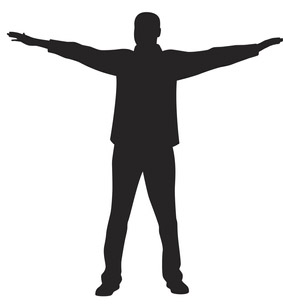Learn
Types of Flexibility Stretches
In this lesson, we will discuss four different types of stretching: Static, Ballistic, Dynamic, and PNF (Proprioceptive Neuromuscular Facilitation).
Static Stretching
Static stretching involves passively stretching a muscle to the point of mild discomfort. It can be divided into two categories:
- Active stretches are performed by an individual without help from a machine or another person.
- Passive stretches are performed using equipment or another person, and without help from the individual who is being stretched.
Static stretches are the most common form of cooldown stretching activities. These are the types of stretches we have been performing since Unit 1.
Recommendations for hold time:
- Recommendations range from 10 to 60 seconds.
- Optimal hold time 30 seconds.
Ballistic Stretching
Ballistic stretching uses quick, bouncing motions to quickly alternate between contracting and relaxing muscles.
This activates multiple muscular structures, which normally prevents overstretching in order to protect body from injury. It also leads to an increased stretch when compared to active or passive stretching.
Ballistic stretching can be very effective if done correctly and under control.
Caution: Ballistic stretching can be dangerous if performed incorrectly.
Ballistic Stretching - Example
Trunk Rotator
Arms are extended laterally. Twist to the left and then to the right.

Dynamic Stretching
Dynamic stretching uses speed of movement, momentum and active muscular effort to bring about a stretch.
Stretching often incorporates movements that mimic a specific sport or exercise in an exaggerated yet controlled manner.
They are typically included during the warm-up or in preparation for a sports event.
Dynamic Stretching - Example
Skipping
Just like you did as a child. Skipping teaches you to keep your hips underneath you. Try to land flat-footed or near your heel and push into the ground with each step.
Dynamic Warm-Up Routine
Perform all dynamic exercises one length of a volleyball court (about 75 feet or 25 big steps) and perform all static exercises for 15 seconds each leg. Work on body positioning (toe up, knee up, arm drive, chest tall) and body balance.
Forward and Backward Jogging
Open Forward and Backward Jogging in a new tab
Calf Stretch
Target: calf, hamstring
Open Calf Stretch in a new tab
Forward and Backward Ankle Flips
Target: calf, ankles
Open Forward and Backward Ankle Flips in a new tab
Forward and Backward Skips
Target: calf, ankles
Open Forward and Backward Skips in a new tab
Quad Stretch
Target: quadriceps
Open Quad Stretch in a new tab
Forward and Backward Butt Kicks
Target: quadriceps and hamstrings
Open Forward and Backward Butt Kicks in a new tab
Saddle Stretch
Target: groin
Open Saddle Stretch in a new tab
Exaggerated Wide Knee Skips
Target: groin, hip flexors
Open Exaggerated Wide Knee Skips in a new tab
Front to Back Leg Swings
Target: hamstrings
Open Front to Back Leg Swings in a new tab
Frankenstein Walk/Skips
Target: hamstrings, calf
Open Frankenstein Walk/Skips in a new tab
High Knee Skips
Target: calf
Open High Knee Skips in a new tab
Bound Skips
Target: calf
Hudler Stretch
Target: groin, hip flexor
Open Hudler Stretch in a new tab
Pendulum Swings Side to Side
Target: groin, hip flexor
Open Pendulum Swings Side to Side in a new tab
Carioca / Grapevine
Target: hip flexor
Open Carioca / Grapevine in a new tab
Backward Jog to Forward Sprint
Open Backward Jog to Forward Sprint in a new tab
PNF
PNF stands for Proprioceptive Neuromuscular Facilitation.
It combines active and passive stretching. It involves a partner actively stretching the participant by some combination of altering contraction and relaxation of both agonist and antagonist muscles.
After the muscle is contracted for 5-10 seconds, it is then moved further through the ROM. The process is then repeated until muscle reaches desired level of flexibility.
PNF Example
Partner-Assisted Hamstring Stretch
Sit erect on the ground with legs together. The partner kneels behind the exerciser. If the partner stands, they may apply too much pressure to the exerciser. The partner places light pressure on the exerciser’s upper back until the exerciser’s forward motion results in mild discomfort. This position should be held for 10 - 30 seconds.
Physical Activity
In this lesson, you are learning about the difference in dynamic exercises and static exercises. You will focus on applying dynamic exercises with your static exercises to your warm up during this lesson.
Jogging
Your physical activity will be jogging. Your goal is to use a dynamic and static warm-up to prepare your body for a workout.
Through this week's activities, you will learn:
- How to choose dynamic exercises and combine with static exercises for a warm-up activity.
- How you feel after your 10 minutes warm-up.
- How you feel after you complete your 30 minutes of jogging.
- To assess if you achieved your heart rate zone after each workout.
Add all the stretches in the dynamic warm-up routine to your workouts.